Chemistry, Department of: Faculty Series

Xiao Cheng Zeng Publications
Document Type
Article
Date of this Version
2015
Citation
PNAS, September 1, 2015, vol. 112, no. 35, pp. 10851–10856.
Abstract
Recently reported synthetic organic nanopore (SONP) can mimic a key feature of natural ion channels, i.e., selective ion transport. However, the physical mechanism underlying the K+/Na+ selectivity for the SONPs is dramatically different from that of natural ion channels. To achieve a better understanding of the selective ion transport in hydrophobic subnanometer channels in general and SONPs in particular, we perform a series of ab initio molecular dynamics simulations to investigate the diffusivity of aqua Na+ and K+ ions in two prototype hydrophobic nanochannels: (i) an SONP with radius of 3.2 Å, and (ii) single-walled carbon nanotubes (CNTs) with radii of 3–5 Å (these radii are comparable to those of the biological potassium K+ channels). We find that the hydration shell of aqua Na+ ion is smaller than that of aqua K+ ion but notably more structured and less yielding. The aqua ions do not lower the diffusivity of water molecules in CNTs, but in SONP the diffusivity of aqua ions (Na+ in particular) is strongly suppressed due to the rugged inner surface. Moreover, the aqua Na+ ion requires higher formation energy than aqua K+ ion in the hydrophobic nanochannels. As such, we find that the ion (K+ vs. Na+) selectivity of the (8, 8) CNT is approx. 20× higher than that of SONP. Hence, the (8, 8) CNT is likely the most efficient artificial K+ channel due in part to its special interior environment in which Na+ can be fully solvated, whereas K+ cannot. This work provides deeper insights into the physical chemistry behind selective ion transport in nanochannels.


Comments
Copyright 2015. Used by permission.